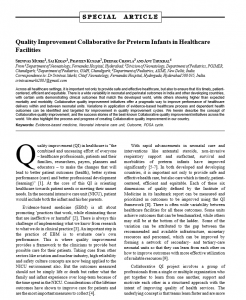
Quality improvement (QI) in healthcare is “the combined and unceasing effort of everyone – healthcare professionals, patients and their families, researchers, payers, planners and educators – to make the changes that will lead to better patient outcomes (health), better system performance (care) and better professional development (learning)”. At the core of this QI is orienting healthcare towards patient needs or meeting their unmet needs. In the neonatal intensive care unit (NICU), patient would include both the infant and his/her parents.
Evidence-based medicine (EBM) is all about promoting ‘practices that work, while eliminating those that are ineffective or harmful’. There is always this challenge of implementing what we know from research to what we do in clinical practice. An important step in the practice of EBM is to evaluate one’s own performance. This is where quality improvement provides a framework to the clinicians to provide best possible care for their patients. Taking cues from other sectors like aviation and nuclear industry, high reliability and safety culture concepts are now being applied to the NICU environment also. But the outcomes measured should not be simply life or death but rather what the family and infant experience over long-term because of the time spent in the NICU. Considerations of the lifetime outcomes have shown to improve care for patients and are the most important measures to collect.
With rapid advancements in neonatal care and interventions like antenatal steroids, non-invasive respiratory support and surfactant, survival and morbidities of preterm infants have improved significantly. In both developed and developing countries, it is important not only to provide safe and effective health care, but also care which is timely, patient-centered, efficient and equitable. Each of these six dimensions of quality defined by the Institute of Medicine in its landmark report can be measured and prioritized as outcomes to be improved using the QI framework. There is often wide variability between healthcare facilities for all these outcomes. Some units achieve outcomes that can be benchmarked, while others may still be at the bottom of the ladder. Some of the variation can be attributed to the gap between the recommended and available infrastructure, monetary resources and personnel, which can be improved by forming a network of secondary- and tertiary-care neonatal units so that they can learn from each other on how to improve outcomes with more effective utilization of available resources.
Collaborative QI project involves a group of professionals from a single or multiple organization who get together to learn from one another, support and motivate each other in a structured approach with the intent of improving quality of health services. The underlying concept is that teams learn faster and are more effective in implementing and spreading improvement ideas and assessing their own progress when collaborating and benchmarking with each other. Collaborative initiatives provide an unique opportunity to look into various clinical practices, outcomes and healthcare costs across different participating units, which are operating in similar demographic and economic conditions. Benchmarking these variations in clinical practices and outcomes is a powerful motivator for participating teams to improve many outcomes, as it represents what has been achieved locally by one’s peers.
Collaborative QI methodology was started in North America in the late 1980s (New England Cardiovascular Disease Study Group, 1986 and Vermont Oxford Network, 1988) with the approach becoming more popular as the Breakthrough Series by the Institute for Healthcare Improvement (IHI) in 1995. Neonatal collaborative QI (Web Table I) projects have ranged from collaborative working to improve the administration of antenatal steroids to eligible mothers to compliance with transfusion guidelines.
—
This special issue of Indian Pediatrics (September 2018; Volume 55: Number 9) highlights mechanisms that can support health care providers in using various quality improvement (QI) approaches and showcases some of the improvement projects undertaken in India by different teams.
The USAID ASSIST Project started working in India in September 2013; initially working directly with districts and facilities to help them learn how to use QI approaches to save lives. This work went well and the staff in these facilities were able to reduce perinatal mortality by 15% over 18 months. During this time, we met great partners from important organizations and institutions across India.
These institutions are now leading a growing movement to help more people apply QI methods to deliver care that prevents harm, improves outcomes, and meets the needs of the people receiving it through their own networks using domestic funding; continuing these lifesaving efforts after ASSIST technical support has ended.
The supplement shows important results of the ongoing QI work in these networks and shows how domestic QI networks, earlier supported by ASSIST, are now independently supporting and spreading the use of QI methods to provide better care.